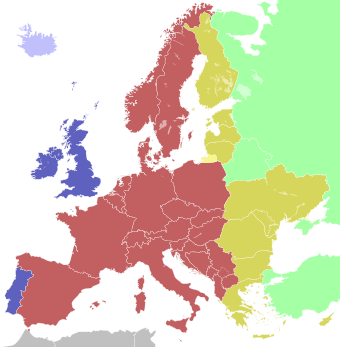Time in Sweden facts for kids

| blue | Western European Time (UTC+0) Western European Summer Time (UTC+1) |
| light blue | Western European Time (UTC+0) |
| red | Central European Time (UTC+1) Central European Summer Time (UTC+2) |
| yellow | Eastern European Time (UTC+2) Eastern European Summer Time (UTC+3) |
| orange | Kaliningrad Time (UTC+3) |
| green | Further-eastern European Time (UTC+3), a.k.a. Moscow Time |
Sweden, a country located in Northern Europe, uses a time zone called Central European Time (CET). This means that the time in Sweden is always one hour ahead of Coordinated Universal Time (UTC+1). An interesting fact is that Sweden has not used summer time since 1916, which means its clocks do not change forward or backward during the year.
Contents
Understanding Time in Sweden
Time zones help us keep track of time around the world. They make sure that noon happens when the sun is highest in the sky, no matter where you are. Sweden's time zone, CET, is common across many European countries.
What is Central European Time (CET)?
Central European Time, or CET, is a standard time zone that is used in many parts of Europe. It is exactly one hour ahead of Coordinated Universal Time (UTC+1). This means if it's 12:00 PM (noon) UTC, it would be 1:00 PM in Sweden. CET is also known as Middle European Time (MET) in some places.
What is Coordinated Universal Time (UTC)?
Coordinated Universal Time, or UTC, is the main time standard that the world uses. It's like the global clock that all other time zones are measured against. UTC is based on atomic clocks, which are super accurate. When you hear about time zones like UTC+1 or UTC-5, it means they are a certain number of hours ahead or behind UTC.
Why Does Sweden Use CET?
Sweden uses CET because of its location on the globe. Many countries in central and western Europe also use CET. This helps make travel and communication easier between these countries. Imagine if every country had its own unique time zone! It would be very confusing. Using common time zones helps keep things organized.
No Daylight Saving Time in Sweden
Daylight Saving Time (DST), sometimes called summer time, is when clocks are moved forward by one hour during warmer months. This is usually done to make evenings lighter and save energy. However, Sweden stopped observing daylight saving time way back in 1916. This means that unlike many other countries, Sweden's clocks do not change twice a year. The time in Sweden stays the same all year round, always UTC+1.
How Time Zones Work
The Earth is divided into 24 main time zones, each roughly 15 degrees of longitude wide. As the Earth spins, different parts of the world face the sun, causing day and night. Time zones help us adjust our clocks to match the sun's position. This way, when it's morning where you are, it's also morning for people in the same time zone, even if they are far away.

